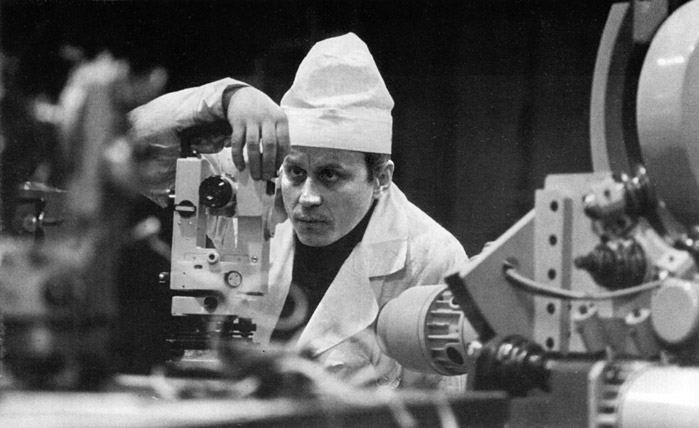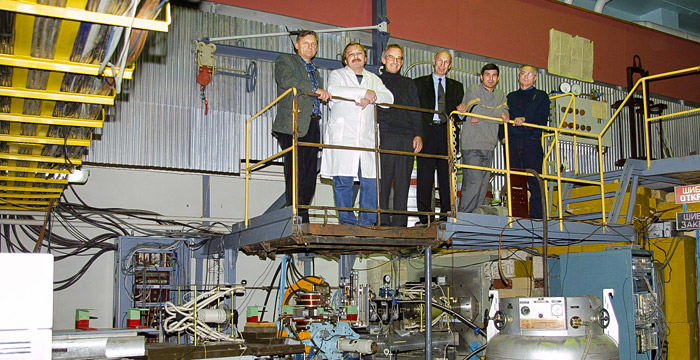
Electronic english version since 2022 |
The newspaper was founded in November 1957
| |
To the 40th anniversary of the IBR-2 reactor
Anniversary. Story. Development
On 29 February, the Frank Laboratory of Neutron Physics hosted the second laboratory-wide seminar in the series dedicated to the 40th anniversary of putting the IBR-2 reactor into operation. The report "Reflectometry of polarized neutrons" was made by the chief researcher of FLNP V.L.Aksenov.
The report was subtitled "Three stages of the path. Results. Areas of Development", since the round date, as the speaker noted, is a point from which one can and should look back, see what has been done and understand where to move. Viktor Lazarevich began with history. The IBR-2 department was established in 1966. Work on organizing the infrastructure for condensed matter physics at the new reactor started in 1970, headed by Yu.M.Ostanevich. New (compared to IBR-30) research areas were proposed, including polarized neutron optics. Anton Bajorek, a physicist from Poland, was appointed in charge. It should be noted that Polish physicists played a major role both in the initial period of development of pulsed reactors and later - at IBR 2. B.Buras initiated time-of-flight diffraction at the first IBR reactor in the early 1960s. As a result, Dubna became the birthplace of this basic research technique using pulsed neutron sources. E.Janik founded a new technique of inelastic scattering at IBR and the Krakow-Dubna Reverse Geometry Spectrometer (KDRGS) was developed. This area is carried out today by D.Chudoba.
In the early 1970s, A.Bayorek attracted D.A.Korneev to the work that was then a trainee in V.M.Nazarov's group and was engaged in simulating mirror curved neutron guides. The neutron guides developed by Vladimir Maksimovich operated at the IBR-2 reactor until the mid-1990s. After Bayorek had left for Poland in 1975, Dmitry Anatolievich Korneev took his place as Head of the Department of Polarized Neutrons. The necessary support was provided to him by Yu.M.Ostanevich and Dmitry Anatolievich mastered the physics and technology of polarized neutrons in Gatchina at the Leningrad Institute of Nuclear Physics of the USSR Academy of Sciences. In 1979, he invented a spin flipper for his polarized neutron spectrometer (PNS) that became known as the Korneev spin flipper.

D.A.Korneev
In 1984, the PNS was installed at the IBR-2 reactor on beamline No.8. The decisive role was played by cooperation with physicists from Magdeburg (GDR), at whose factories the main components of the spectrometer were manufactured, with high quality and on time. The first years of research were carried out using the technique of depolarizing neutrons as they passed through magnetic samples. In 1988, regular experiments on polarized neutron reflectometry began. The first stage was completed, FLNP became one of the pioneers of this technique in the world.
In the early 1990s, D.A.Korneev figured out how to increase the intensity of the neutron beam in reflectometers. He moved to beamline No.9 and together with L.P.Chernenko and V.I.Bodnarchuk, began to realize his idea. In 1996, a new polarized neutron spectrometer, REFLEX, was developed, on which original investigations of inelastic neutron scattering on vibrations of the surfaces of magnetic and non-magnetic substances were carried out. Currently, the REFLEX-P spectrometer (that came into operation in 2001 after the modernization of the first version) possesses a niche that is very important for further development; it is used to work out methodological issues in polarized neutron reflectometry.
The second stage, noted by the speaker, refers to the modernization and development of the PNS. In 1997, the PNS-2 was put into operation, on which, among other things, experiments were carried out to study high-temperature superconductors and the phenomenon of giant magnetoresistance. Then, on the basis of the PNS-2, a new reflectometer REMUR was developed that became completely operational on beamline No.8 of the IBR-2 reactor in 2003 and stood out against the world background with its characteristics. Thus, all the conditions were provided for the development of the most advanced three-dimensional reflectometry. Viktor Lazarevich spoke about experiments on 3D reflectometry using the example of thin films of copolymers with impurities of magnetic nanoparticles.

Yu.V.Nikitenko, A.V.Petrenko, H.Lauter, V.L.Aksenov, S.V.Kozhevnikov, V.A.Ulyanov in the experimental hall of IBR-2. 2003
Hans Lauter, a German employee of the Laue-Langevin Institute (Grenoble) holds a special place at this stage. He together with V.V.Lauter-Pasyuk and the speaker proposed the ideology of the project. Yu.V.Nikitenko, together with A.V.Petrenko, S.V.Kozhevnikov carried out a huge technical work. The participation of PNPI employees - National Research Centre "Kurchatov Institute" V.A.Ulyanov and B.P.Toperverg was very useful. The financing of the project from the German contribution to JINR played a decisive role.
The third, modern stage in the development of polarized neutron reflectometry at FLNP concerns the development of techniques for resonant amplification of the neutron wave field or amplified neutron standing waves. This topic was initiated by the work of our colleagues at the National Institute of Standards and Technology (Gaithersburg, Maryland, USA) that were the first to observe amplified standing neutron waves in thin polymer films using a nuclear reaction of radiative capture by gadolinium isotopes with gamma-ray radiation. The author of the report initiated similar investigations at FLNP. Yu.V.Nikitenko, A.V.Petrenko, S.V.Kozhevnikov and V.D.Zhaketov, with the participation of employees of the Department of Nuclear Physics of FLNP Yu.M.Gledenov, N.A.Gundorin, Yu.N.Kopach and P.V.Sedysheva, extended the technique to reactions with the release of charged particles. Of particular interest is the technique of resonant amplification and registration of standing waves of polarized neutrons proposed by the author of the report together with Yu.V.Nikitenko. Currently, a complex for neutron spectrometry in sliding geometry with registration of secondary radiation in the mode of a resonantly enhanced neutron wave field has been developed on the REMUR reflectometer.
Summing up, the speaker highlighted that seven candidate's theses and two doctoral theses were prepared and defended using the REFLEX and REMUR reflectometers. In 2013, another GRAINS reflectometer started operating that allows to study liquid surfaces, relevant, in particular, for biology and polymer physics. However, GRAINS does not have a polarization analysis yet, so it was not included in the report.
V.L.Aksenov shared his thoughts on the development of reflectometry at the NEPTUNE reactor that will have a 10 times greater neutron flux than at IBR-2. The speaker named real-time reflectometry as a promising area; reflectometry with Larmor precession; inelastic neutron scattering on a surface.
Viktor Lazarevich concluded his report with a slide indicating two papers by D.A.Korneev on fundamental issues of neutron optics in collaboration with V.K.Ignatovich and a quote from Dmitry Anatolievich's diary in 1974: "We don't want to receive nonsense tasks... We dream of super tasks, so that if we succeed, we can be proud of it all our lives." The seminar was dedicated not only to the 40th anniversary of the reactor, but also to the memory of D.A.Korneev as the founder of polarized neutron reflectometry at FLNP.
Answering questions, V.L.Aksenov noted that when discussing the strategy for the development of neutron research in the field of condensed matter physics and the scientific justification of a new neutron source at JINR, first of all, it is necessary to formulate areas for the rapid development of experimental capabilities in order to be prepared for new and often unexpected challenges of Nature. "To exaggerate, I will say that if you make a device with parameters that are an order of magnitude better than the operating ones, then you are doomed to a discovery. Surely, we are talking about record-breaking devices at the moment," the speaker concluded his speech.
Olga TARANTINA,
photo from the FLNP archive